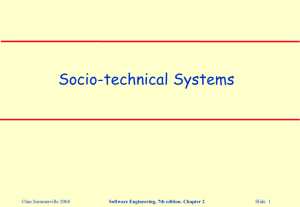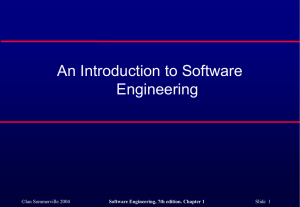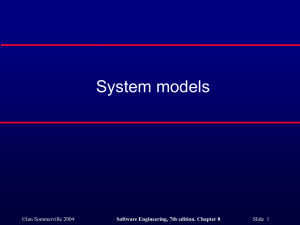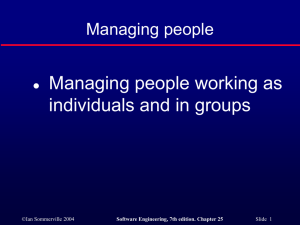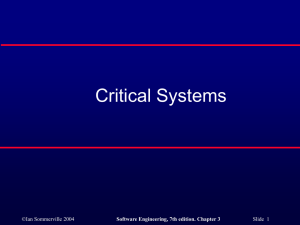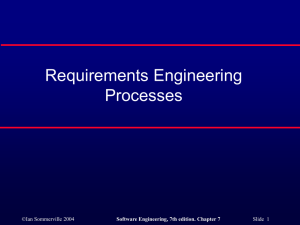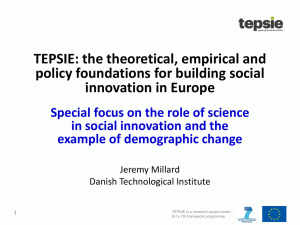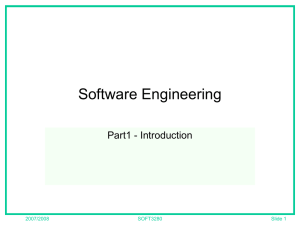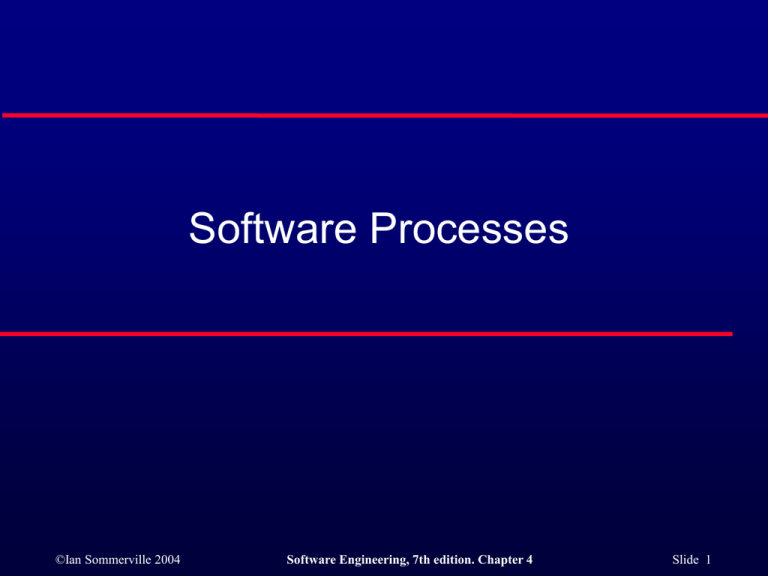
Software Processes
©Ian Sommerville 2004
Software Engineering, 7th edition. Chapter 4
Slide 1
Objectives
To introduce software process models
To describe three generic process models and
when they may be used
To describe outline process models for
requirements engineering, software
development, testing and evolution
To explain the Rational Unified Process model
To introduce CASE technology to support
software process activities
©Ian Sommerville 2004
Software Engineering, 7th edition. Chapter 4
Slide 2
Topics covered
Software process models
Process iteration
Process activities
The Rational Unified Process
Computer-aided software engineering
©Ian Sommerville 2004
Software Engineering, 7th edition. Chapter 4
Slide 3
The software process
A structured set of activities required to develop a
software system
•
•
•
•
Specification;
Design;
Validation;
Evolution.
A software process model is an abstract representation
of a process. It presents a description of a process
from some particular perspective.
©Ian Sommerville 2004
Software Engineering, 7th edition. Chapter 4
Slide 4
Generic software process models
The waterfall model
•
Evolutionary development
•
Specification, development and validation are
interleaved.
Component-based software engineering
•
Separate and distinct phases of specification and
development.
The system is assembled from existing components.
There are many variants of these models e.g. formal
development where a waterfall-like process is used but
the specification is a formal specification that is refined
through several stages to an implementable design.
©Ian Sommerville 2004
Software Engineering, 7th edition. Chapter 4
Slide 5
Waterfall model
©Ian Sommerville 2004
Software Engineering, 7th edition. Chapter 4
Slide 6
Waterfall model phases
Requirements analysis and definition
System and software design
Implementation and unit testing
Integration and system testing
Operation and maintenance
The main drawback of the waterfall model is
the difficulty of accommodating change after
the process is underway. One phase has to be
complete before moving onto the next phase.
©Ian Sommerville 2004
Software Engineering, 7th edition. Chapter 4
Slide 7
Waterfall model problems
Inflexible partitioning of the project into distinct stages
makes it difficult to respond to changing customer
requirements.
Therefore, this model is only appropriate when the
requirements are well-understood and changes will be
fairly limited during the design process.
Few business systems have stable requirements.
The waterfall model is mostly used for large systems
engineering projects where a system is developed at
several sites.
©Ian Sommerville 2004
Software Engineering, 7th edition. Chapter 4
Slide 8
Evolutionary development
Exploratory development
•
Objective is to work with customers and to evolve
a final system from an initial outline specification.
Should start with well-understood requirements
and add new features as proposed by the
customer.
Throw-away prototyping
•
Objective is to understand the system
requirements. Should start with poorly understood
requirements to clarify what is really needed.
©Ian Sommerville 2004
Software Engineering, 7th edition. Chapter 4
Slide 9
Evolutionary development
©Ian Sommerville 2004
Software Engineering, 7th edition. Chapter 4
Slide 10
Evolutionary development
Problems
•
•
•
Lack of process visibility;
Systems are often poorly structured;
Special skills (e.g. in languages for rapid
prototyping) may be required.
Applicability
•
•
•
For small or medium-size interactive systems;
For parts of large systems (e.g. the user interface);
For short-lifetime systems.
©Ian Sommerville 2004
Software Engineering, 7th edition. Chapter 4
Slide 11
Component-based software engineering
Based on systematic reuse where systems are
integrated from existing components or COTS
(Commercial-off-the-shelf) systems.
Process stages
•
•
•
•
Component analysis;
Requirements modification;
System design with reuse;
Development and integration.
This approach is becoming increasingly used
as component standards have emerged.
©Ian Sommerville 2004
Software Engineering, 7th edition. Chapter 4
Slide 12
Reuse-oriented development
©Ian Sommerville 2004
Software Engineering, 7th edition. Chapter 4
Slide 13
Process iteration
System requirements ALWAYS evolve in the
course of a project so process iteration where
earlier stages are reworked is always part of
the process for large systems.
Iteration can be applied to any of the generic
process models.
Two (related) approaches
•
•
Incremental delivery;
Spiral development.
©Ian Sommerville 2004
Software Engineering, 7th edition. Chapter 4
Slide 14
Incremental delivery
Rather than deliver the system as a single delivery, the
development and delivery is broken down into
increments with each increment delivering part of the
required functionality.
User requirements are prioritised and the highest
priority requirements are included in early increments.
Once the development of an increment is started, the
requirements are frozen though requirements for later
increments can continue to evolve.
©Ian Sommerville 2004
Software Engineering, 7th edition. Chapter 4
Slide 15
Incremental development
©Ian Sommerville 2004
Software Engineering, 7th edition. Chapter 4
Slide 16
Incremental development advantages
Customer value can be delivered with each
increment so system functionality is available
earlier.
Early increments act as a prototype to help
elicit requirements for later increments.
Lower risk of overall project failure.
The highest priority system services tend to
receive the most testing.
©Ian Sommerville 2004
Software Engineering, 7th edition. Chapter 4
Slide 17
Extreme programming
An approach to development based on the
development and delivery of very small
increments of functionality.
Relies on constant code improvement, user
involvement in the development team and
pairwise programming.
Covered in Chapter 17
©Ian Sommerville 2004
Software Engineering, 7th edition. Chapter 4
Slide 18
Spiral development
Process is represented as a spiral rather than
as a sequence of activities with backtracking.
Each loop in the spiral represents a phase in
the process.
No fixed phases such as specification or
design - loops in the spiral are chosen
depending on what is required.
Risks are explicitly assessed and resolved
throughout the process.
©Ian Sommerville 2004
Software Engineering, 7th edition. Chapter 4
Slide 19
Spiral model of the software process
©Ian Sommerville 2004
Software Engineering, 7th edition. Chapter 4
Slide 20
Spiral model sectors
Objective setting
•
Risk assessment and reduction
•
Risks are assessed and activities put in place to reduce
the key risks.
Development and validation
•
Specific objectives for the phase are identified.
A development model for the system is chosen which
can be any of the generic models.
Planning
•
The project is reviewed and the next phase of the spiral
is planned.
©Ian Sommerville 2004
Software Engineering, 7th edition. Chapter 4
Slide 21
Process activities
Software specification
Software design and implementation
Software validation
Software evolution
©Ian Sommerville 2004
Software Engineering, 7th edition. Chapter 4
Slide 22
Software specification
The process of establishing what services are
required and the constraints on the system’s
operation and development.
Requirements engineering process
•
•
•
•
Feasibility study;
Requirements elicitation and analysis;
Requirements specification;
Requirements validation.
©Ian Sommerville 2004
Software Engineering, 7th edition. Chapter 4
Slide 23
The requirements engineering process
©Ian Sommerville 2004
Software Engineering, 7th edition. Chapter 4
Slide 24
Software design and implementation
The process of converting the system
specification into an executable system.
Software design
•
Implementation
•
Design a software structure that realises the
specification;
Translate this structure into an executable
program;
The activities of design and implementation
are closely related and may be inter-leaved.
©Ian Sommerville 2004
Software Engineering, 7th edition. Chapter 4
Slide 25
Design process activities
Architectural design
Abstract specification
Interface design
Component design
Data structure design
Algorithm design
©Ian Sommerville 2004
Software Engineering, 7th edition. Chapter 4
Slide 26
The software design process
©Ian Sommerville 2004
Software Engineering, 7th edition. Chapter 4
Slide 27
Structured methods
Systematic approaches to developing a
software design.
The design is usually documented as a set of
graphical models.
Possible models
•
•
•
•
•
Object model;
Sequence model;
State transition model;
Structural model;
Data-flow model.
©Ian Sommerville 2004
Software Engineering, 7th edition. Chapter 4
Slide 28
Programming and debugging
Translating a design into a program and
removing errors from that program.
Programming is a personal activity - there is
no generic programming process.
Programmers carry out some program testing
to discover faults in the program and remove
these faults in the debugging process.
©Ian Sommerville 2004
Software Engineering, 7th edition. Chapter 4
Slide 29
The debugging process
©Ian Sommerville 2004
Software Engineering, 7th edition. Chapter 4
Slide 30
Software validation
Verification and validation (V & V) is intended
to show that a system conforms to its
specification and meets the requirements of
the system customer.
Involves checking and review processes and
system testing.
System testing involves executing the system
with test cases that are derived from the
specification of the real data to be processed
by the system.
©Ian Sommerville 2004
Software Engineering, 7th edition. Chapter 4
Slide 31
The testing process
©Ian Sommerville 2004
Software Engineering, 7th edition. Chapter 4
Slide 32
Testing stages
Component or unit testing
•
•
System testing
•
Individual components are tested independently;
Components may be functions or objects or
coherent groupings of these entities.
Testing of the system as a whole. Testing of
emergent properties is particularly important.
Acceptance testing
•
Testing with customer data to check that the
system meets the customer’s needs.
©Ian Sommerville 2004
Software Engineering, 7th edition. Chapter 4
Slide 33
Testing phases
©Ian Sommerville 2004
Software Engineering, 7th edition. Chapter 4
Slide 34
Software evolution
Software is inherently flexible and can change.
As requirements change through changing
business circumstances, the software that
supports the business must also evolve and
change.
Although there has been a demarcation
between development and evolution
(maintenance) this is increasingly irrelevant as
fewer and fewer systems are completely new.
©Ian Sommerville 2004
Software Engineering, 7th edition. Chapter 4
Slide 35
System evolution
©Ian Sommerville 2004
Software Engineering, 7th edition. Chapter 4
Slide 36
The Rational Unified Process
A modern process model derived from the
work on the UML and associated process.
Normally described from 3 perspectives
•
•
•
A dynamic perspective that shows phases over
time;
A static perspective that shows process activities;
A practive perspective that suggests good
practice.
©Ian Sommerville 2004
Software Engineering, 7th edition. Chapter 4
Slide 37
RUP phase model
Phase iteration
Inception
©Ian Sommerville 2004
Elaboration
Construction
Software Engineering, 7th edition. Chapter 4
Transition
Slide 38
RUP phases
Inception
•
Elaboration
•
Develop an understanding of the problem domain
and the system architecture.
Construction
•
Establish the business case for the system.
System design, programming and testing.
Transition
•
Deploy the system in its operating environment.
©Ian Sommerville 2004
Software Engineering, 7th edition. Chapter 4
Slide 39
RUP good practice
Develop software iteratively
Manage requirements
Use component-based architectures
Visually model software
Verify software quality
Control changes to software
©Ian Sommerville 2004
Software Engineering, 7th edition. Chapter 4
Slide 40
Static workflows
Wor kfl ow
De scr ip tio n
Bu si nes s m ode lli ng
T he bu si nes s p roce sse s a re m ode ll ed u si ng bu si nes s u se c ase s.
R e qui rem en ts
Ac to rs who interac t w it h the sy st em a re i den ti fied and use ca ses ar e
deve loped t o m ode l t he sys tem re qu ire m en ts .
Ana lysi s and de si gn
A des ign m ode l is crea ted and do c u m en ted u si ng a rch it ec tu ral
m ode ls, c om ponen t m ode ls , obj e ct m ode ls and sequ e nce mod el s.
Im pl em en tati on
T he co m pon e nt s in t he sys tem are im p lem en ted and st ru ct ured i n to
im plem en tati on sub- sys tems . Au to m ati c c ode gen e ra ti on fro m d e sign
m ode ls he lps ac c eler at e this p roces s.
T es t
T es ti ng is a n it erati ve p roce ss tha t is ca rri ed ou t i n con junc ti on w it h
im plem en tati on. S ys tem te sti ng foll ows t he c o m pl et ion of the
im plem en tati on.
Dep loy m en t
A produc t rel eas e is crea ted , d ist ribu ted t o us e rs and i ns tall ed i n the ir
wo rkp lace .
Con fi gu rati on and
chang e m anag e m e n t
T hi s suppo rting wo rkf low m anaged
Ch a pt e r 29) .
P ro je ct m anag e m e n t
T hi s suppo rting wo rkf low m anage s the sy st em deve lop m en t (see
Ch a pt e r 5) .
E nvi ron m en t
T hi s w ork fl ow is con c ern e d w it h ma king app ropr ia te s of twa re t oo ls
ava il ab le t o the so ft wa re deve lop m en t tea m .
©Ian Sommerville 2004
change s to th e sys tem (see
Software Engineering, 7th edition. Chapter 4
Slide 41
Computer-aided software engineering
Computer-aided software engineering (CASE) is
software to support software development and
evolution processes.
Activity automation
•
•
•
•
•
Graphical editors for system model development;
Data dictionary to manage design entities;
Graphical UI builder for user interface construction;
Debuggers to support program fault finding;
Automated translators to generate new versions of a
program.
©Ian Sommerville 2004
Software Engineering, 7th edition. Chapter 4
Slide 42
Case technology
Case technology has led to significant
improvements in the software process.
However, these are not the order of magnitude
improvements that were once predicted
•
•
Software engineering requires creative thought this is not readily automated;
Software engineering is a team activity and, for
large projects, much time is spent in team
interactions. CASE technology does not really
support these.
©Ian Sommerville 2004
Software Engineering, 7th edition. Chapter 4
Slide 43
CASE classification
Classification helps us understand the different types
of CASE tools and their support for process activities.
Functional perspective
•
Process perspective
•
Tools are classified according to their specific function.
Tools are classified according to process activities that
are supported.
Integration perspective
•
Tools are classified according to their organisation into
integrated units.
©Ian Sommerville 2004
Software Engineering, 7th edition. Chapter 4
Slide 44
Functional tool classification
T o ol t yp e
E x am ples
P la n ning to ols
P ERT too ls, estim at ion to ols , sprea dshe et s
E d it ing to ols
Te x t e di tors , d ia gram e d itors , w ord proc essors
C h an ge ma na g em en t too ls
R e qu irem en ts trac e ab ili ty to ol s, ch an g e c o ntro l s yste m s
C o nfig uratio n m an ag em en t to ols
V er sion m an ag e m e nt s ystems , sys te m b uild in g t oo ls
P ro to ty ping to ols
V er y h ig h-le v el la n gu ag es , us er in te rfa ce g en er a to rs
M e th od -su pp ort too ls
D esig n e di tors , d ata d ic tio n arie s, co d e g en er a to rs
La n gu ag e -p ro ce ssi ng to ols
C om pile rs , inter pr ete rs
P ro gram a na lysis to ols
C ro ss re fe ren ce g en er a to rs , s ta tic a na lysers , d yn am ic an al ys er s
Te stin g t oo ls
Te st d a ta g en er a to rs, file co mp ar a to rs
D eb u gg in g too ls
Inter a ct ive de b ug ging s ystems
D oc um en tat ion to ols
P ag e l a yo ut prog rams , i ma ge e dito rs
R e -e n gine e ring to ols
C ro ss-r efer e nc e s ystems , p ro gram re-s truc turin g s ystem s
©Ian Sommerville 2004
Software Engineering, 7th edition. Chapter 4
Slide 45
Activity-based tool classification
Re -eng ineering t ools
Testing tools
Debugg
ing tools
Pr og r am analysis tools
La nguage- pr ocessing
t ools
Met hod suppor
t t ools
Pr otot yping tools
Configurat ion
m anagem ent t ools
Change m anagem ent t ools
Docum entat ion t ools
Edit ing tools
Planning tools
Specif ication
©Ian Sommerville 2004
Design
I mplem entat ion
Ver ificat ion
and
Validat ion
Software Engineering, 7th edition. Chapter 4
Slide 46
CASE integration
Tools
•
Workbenches
•
Support individual process tasks such as design
consistency checking, text editing, etc.
Support a process phase such as specification or
design, Normally include a number of integrated
tools.
Environments
•
Support all or a substantial part of an entire
software process. Normally include several
integrated workbenches.
©Ian Sommerville 2004
Software Engineering, 7th edition. Chapter 4
Slide 47
Tools, workbenches, environments
CASE
t echnolo g y
Wor kbenches
Tools
Edit ors
Com pile rs
File
com pa r a t or s
Anal ysis and
design
Mult i-m et hod
w or kbenches
©Ian Sommerville 2004
Single- met hod
w or kbenches
Environment s
I nt eg r at ed
en vironment s
Pr o gr am ming
Pr ocess- centr ed
en vironment s
Testing
Ge ner al- pur pose
w or kbenches
Software Engineering, 7th edition. Chapter 4
La ngua ge- specif ic
w or kbenches
Slide 48
Key points
Software processes are the activities involved in
producing and evolving a software system.
Software process models are abstract representations
of these processes.
General activities are specification, design and
implementation, validation and evolution.
Generic process models describe the organisation of
software processes. Examples include the waterfall
model, evolutionary development and componentbased software engineering.
Iterative process models describe the software process
as a cycle of activities.
©Ian Sommerville 2004
Software Engineering, 7th edition. Chapter 4
Slide 49
Key points
Requirements engineering is the process of developing
a software specification.
Design and implementation processes transform the
specification to an executable program.
Validation involves checking that the system meets to
its specification and user needs.
Evolution is concerned with modifying the system after
it is in use.
The Rational Unified Process is a generic process
model that separates activities from phases.
CASE technology supports software process activities.
©Ian Sommerville 2004
Software Engineering, 7th edition. Chapter 4
Slide 50



